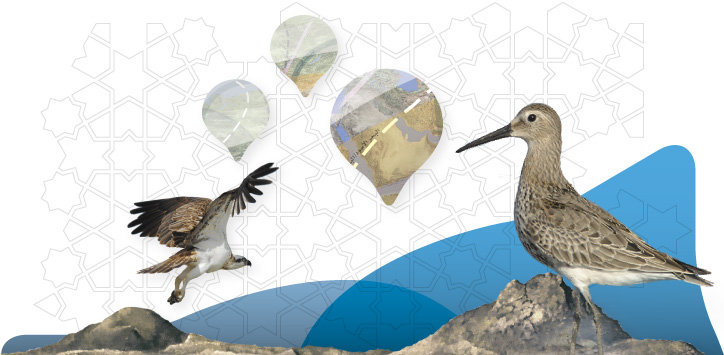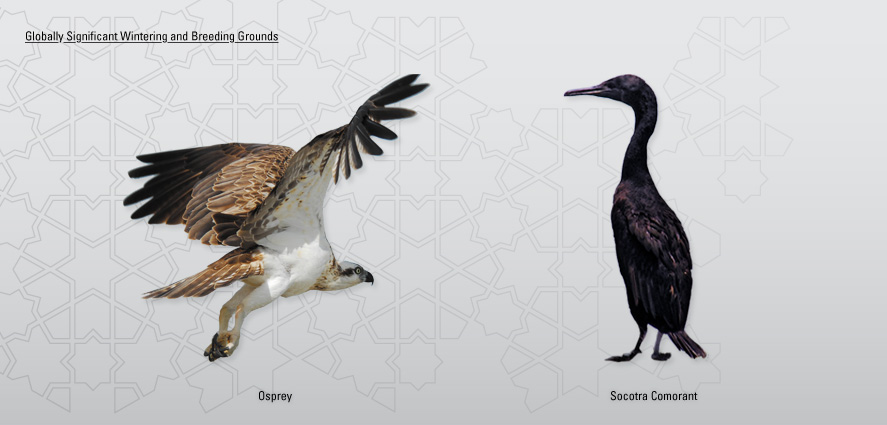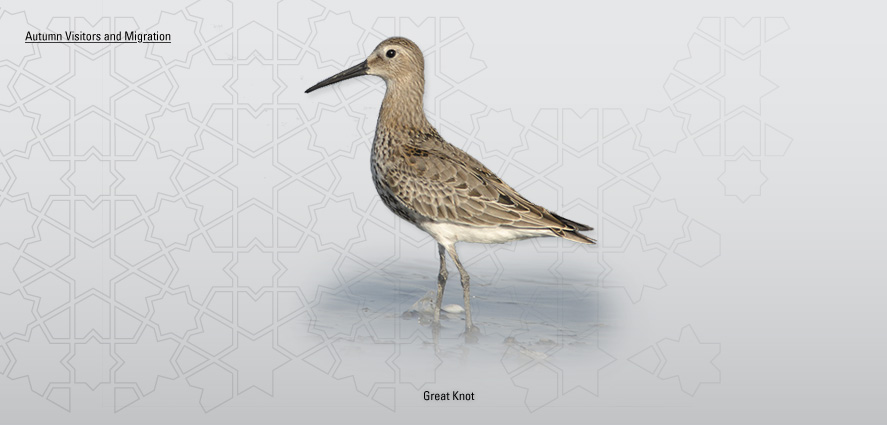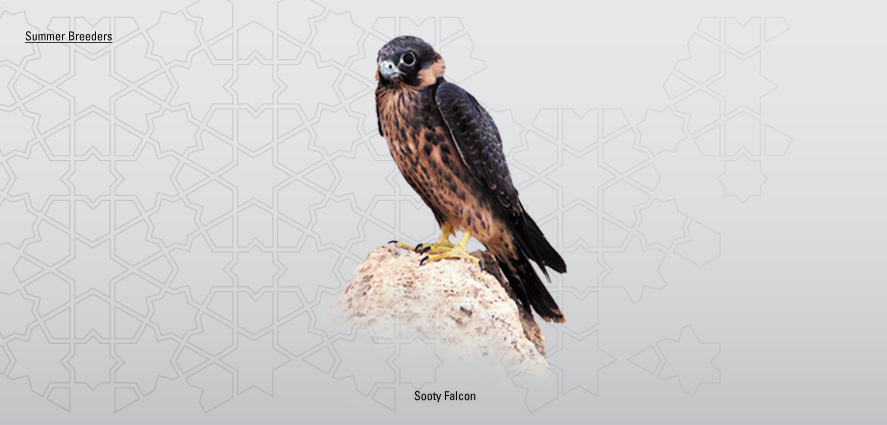
You are in :
Life on the Wing

Regional flyways
Birds are true evolutionary wonders. They possess the remarkable ability to connect countries and continents through migratory movements often requiring long and perilous journeys. Birds from as far away as Eastern Siberia and the Arctic migrate to or through Abu Dhabi each year. During annual migrations, up to three million waterbirds visit the UAE, such a high turnover being linked to the rich productivity of the Gulf for food and its strategic location along two north–south migratory flyways. Known as the ‘Eastern Hotspot of the Western Palaearctic', a large proportion of birds arrive from the Western Palaearctic using the West Asia–East Africa flyway, while others arrive via the Central Asian flyway. Over 180 Palaearctic species stop-over in the Emirate in the winter while en route to sub-Saharan Africa. The migration volume is more pronounced in the spring than in autumn, as several species migrate further west in the autumn (along the Red Sea and African Rift Valley) returning through the Emirate in the spring during their northward journey. A combination of cutting-edge technologies such as satellite telemetry and the tagging of birds (with metal bands) have provided insights about their local movements, migration routes and stopovers. The future of these coastal and island stopover sites remains precarious, threatened by human development. Guaranteeing protection to such habitats and to the many internationally important bird colonies and migrant populations they support is not only essential to the natural heritage of Abu Dhabi, but remains a solemn international obligation.
Disclaimer: The routes and boundaries depicted for the flyways on these pages are indicative and should not be regarded as precise geographical limits or used for determining the habitat boundaries of the relevant species.
Globally Significant Wintering and Breeding Grounds

An estimated 250,000 shorebirds are present at any given time from autumn to spring along the coast of the UAE, from Sila'a in the west to Fujairah in the east. The extensive mudflats and inter–tidal areas along the coastline provide food security to the majority of these wintering shorebirds. In addition, the numerous offshore islands provide a safe breeding refuge for several important species. 75% of the important wintering or breeding sites for nationally and internationally significant bird species within the UAE are found within Abu Dhabi Emirate. Abu Dhabi hosts almost all the breeding Osprey (Pandion haliaetus) in the UAE and supports nearly 80% of its population in the Arabian Gulf. Five of the colonies of the globally threatened Socotra Cormorant (Phalacrocorax nigrogularis) are restricted to islands in the Emirate, while breeding colonies of White-cheeked Tern (Sterna repressa) contain an estimated 5% of the entire world population. Sooty Gulls (Larus hemprichii), another important species, breed on Qarnein and Dayyinah islands, the only two known breeding sites in the country.
Osprey
Over 75% of the Arabian Gulf's breeding population of Osprey (Pandion haliaetus) occurs here in the Emirate, making it a regionally significant site for this spectacular bird of prey. In spite of these impressive numbers, more than 80 per cent of active nest sites have been lost on Yasat al-Ulya and Yasat as Sufla, Ghagha' and Judairah islands. While provision of artificial nesting platforms has certainly benefited Osprey numbers, this is a poor substitute for natural breeding sites.
Socotra Cormorant
Winter heralds the nesting of the threatened Socotra Cormorant (Phalacrocorax nigrogularis). The commotion never ceases on the islands that these birds frequent as they make repeated diving trips to the sea to catch fish. Interestingly, Socotra Cormorant breeding coincides precisely with an increased abundance of small fish in Abu Dhabi's waters.
The Socotra Cormorant is regionally endemic and globally threatened with only 12 surviving colonies known worldwide. Five of them are located in Abu Dhabi. Due to their vulnerability to development and illegal hunting, the protection of the threatened cormorant is extremely urgent!
Autumn Visitors and Migration

Shortening days and dropping temperatures signal the end of summer in the Arctic and birds begin their autumn migrations to more southerly regions. Small Arctic nesting species such as Little Stint (Calidris minuta), Curlew Sandpiper (Calidris ferruginea), Ruddy Turnstone (Arenaria interpres) and Sanderling (Calidris alba) can be seen feeding voraciously on the mudflats along the Abu Dhabi coastline and at a few inland wetlands. Dunlin (Calidris alpina), another Arctic nesting bird, are found in nationally and internationally significant numbers. Other species such as Grey Plover (Pluvialis squatarola), Common Redshank (Tringa totanus), Lesser Sand Plover (Charadrius mongolus), Red-necked Phalarope (Phalaropus lobatus) and Common Ringed Plover (Charadrius hiaticula) can also be observed during the autumn migration.
Great Knot
Breeding in the eastern Siberian region of Russia, the Great Knot's (Calidris tenuirostris) migration to Abu Dhabi is truly spectacular. Although the bulk of the population migrates to north-western Australia for the winter, each year a small population visits and winters in the UAE. The waters of Abu Dhabi, particularly along the western coast are especially attractive for this long-distance visitor. Since it was first recorded in the late 1980s, the species has been seen annually on the mudflats around Marawah Island. Although they typically arrive during the autumn, they become more common and abundant during late winter.
Summer Breeders

Arrival of Tenacious Terns
The summer months bring ferocious temperatures and life-sapping humidity. It is almost impossible to imagine that breeding seabirds could spend entire days under the open sun for weeks on end, tending and guarding their nests. Yet Terns demonstrate this amazing tenacity to incubate and prevent their eggs from spoiling under such adverse conditions. Summer brings a spectacular number of Terns from the Indian Ocean to the islands of Abu Dhabi. From April to July, the islands become a ‘Tern paradise' offering splendid sights for ornithologists. The aggregated colonies of terns on the islands comprise more than 25 per cent of the Lesser Crested Terns (Sterna bengalensis) and Swift Tern (Sterna bergii) populations of the Arabian Gulf and over 30 per cent of the Middle Eastern population of the Bridled Tern (Onychoprion anaethetus).
Sooty Falcon
The Sooty Falcon (Falco concolor) is a bird of prey that migrates to Abu Dhabi in the summer from its wintering grounds in Madagascar. By 2008 only six breeding pairs remained here, down from about 14 in 1994, making the bird one of the most endangered species in the Emirate. All the current breeding pairs are confined to 7 small and largely uninhabited rocky islands. The fact that their breeding coincides with the autumn migration of much-hunted Passerines challenges the survival of this most elegant of migrants.

















